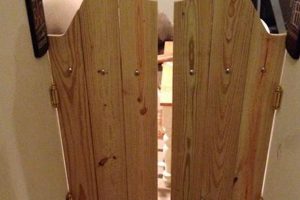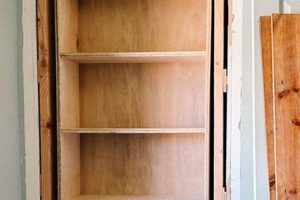The concept involves modifying kitchen storage by removing traditional doors from cabinetry or constructing new cabinets without doors, often undertaken as a do-it-yourself project. This design choice exposes the cabinet’s contents, altering the kitchen’s aesthetic and accessibility. For instance, an individual might remove the doors from existing upper cabinets and refinish the interior to create a more open and visually appealing space.
Open shelving in the kitchen offers several advantages. It can create a sense of spaciousness, particularly in smaller kitchens. Furthermore, it provides easier access to frequently used items, streamlining cooking and daily routines. Historically, open shelving was a common feature in kitchens before the widespread adoption of enclosed cabinetry. The resurgence of this design element reflects a desire for both functional efficiency and a more personalized kitchen environment.
The subsequent sections will delve into the planning stages, design considerations, construction techniques, and maintenance tips associated with achieving successfully executed open kitchen storage solutions.
Essential Considerations for Doorless Kitchen Cabinetry
Implementing doorless kitchen cabinetry requires careful planning and execution to achieve a functional and aesthetically pleasing outcome. The following points offer guidance for those considering this design modification.
Tip 1: Assess Existing Cabinet Structure: Before removing doors, inspect the structural integrity of the cabinets. Ensure the frames are sturdy enough to support the weight of the contents without the added reinforcement provided by doors. Consider adding additional bracing if necessary.
Tip 2: Plan the Layout Strategically: Designate specific cabinets for open display. Ideal candidates include those housing frequently used items such as dishes, glassware, or cookbooks. Avoid exposing cabinets containing clutter or items prone to collecting dust.
Tip 3: Emphasize Interior Aesthetics: Since the cabinet interiors will be visible, prioritize their appearance. Consider painting or refinishing the interior surfaces to complement the overall kitchen dcor. Consistent color schemes contribute to a cohesive visual impact.
Tip 4: Implement Effective Organization Systems: Employ organizational tools, such as shelf dividers, baskets, and clear containers, to maintain a neat and orderly appearance. Consistent use of these systems is crucial for mitigating visual clutter.
Tip 5: Address Dust Accumulation Proactively: Doorless cabinets are more susceptible to dust accumulation. Establish a regular cleaning schedule to prevent dust buildup. Utilize microfiber cloths and appropriate cleaning solutions to maintain cleanliness.
Tip 6: Consider Lighting Enhancements: Integrating lighting within or above the open cabinets can highlight displayed items and improve visibility. LED strip lighting is a practical option for adding subtle illumination.
Tip 7: Choose Hardware Wisely: While doors are absent, consider adding decorative hardware such as knobs or pulls to the cabinet frames. This detail can enhance the visual appeal and provide functional grip points.
Properly executed, these open storage solutions offer enhanced accessibility and visual appeal. However, diligent planning and maintenance are paramount to ensuring long-term functionality and aesthetic satisfaction.
The final section will summarize the advantages and potential drawbacks of this design choice.
1. Preparation
Preparation constitutes a critical phase in any project involving open kitchen cabinets without doors. The absence of doors exposes the cabinet’s interior, necessitating meticulous planning to avoid a cluttered or unorganized appearance. Neglecting preparation can result in mismatched materials, inadequate structural support, or an aesthetically displeasing outcome. For example, failure to accurately measure the cabinet opening before ordering shelves can lead to improperly sized components, requiring costly modifications or replacement.
Effective preparation includes assessing existing cabinet structure to determine its suitability for door removal. This involves inspecting the frame for damage or instability, which must be addressed before proceeding. Strategic layout planning is equally important. Identifying which cabinets will house frequently used items versus less frequently accessed items dictates the organization strategy. Insufficient preparation in this regard can lead to inconvenience and reduced efficiency in the kitchen workflow. Consider the task of storing spices; haphazard arrangement within an open cabinet creates visual chaos and impedes quick access.
In summary, thorough preparation is not merely a preliminary step but an integral component directly influencing the success of creating open kitchen cabinets. It involves structural assessment, strategic layout planning, and meticulous attention to detail. Adequate preparation minimizes errors, optimizes functionality, and ensures a visually appealing result, mitigating the inherent challenges associated with exposed storage. Proper preparation ensures the DIY project aligns with the intended aesthetic and functional goals.
2. Measurement
Accurate measurement is a cornerstone of any successful implementation involving open kitchen cabinets without doors. The dimensional precision dictates the fit and finish of shelves, inserts, and any modifications to the existing cabinet structure. Inaccurate measurements lead directly to ill-fitting components, requiring rework or replacement, thereby escalating project costs and timelines. For instance, when adding shelving to an existing cabinet, if the interior width is miscalculated, the shelf will either be too wide to fit or too narrow, resulting in instability and reduced functionality.
Beyond individual components, measurement extends to the overall spatial design. Determining the proper height and depth of open shelving units relative to countertop space and adjacent appliances ensures ergonomic accessibility. Incorrect measurements in this regard can impede workflow efficiency, creating awkward or uncomfortable reaches. As a practical example, consider a situation where open shelves are positioned too close to a stovetop. This not only increases the risk of heat damage to stored items but also restricts maneuverability during cooking. Conversely, shelving positioned too high may necessitate the use of a step stool, diminishing convenience.
In summary, precise measurement is not merely a technical detail but a fundamental prerequisite for realizing functional and aesthetically pleasing open kitchen storage. It directly influences the structural integrity, ergonomic design, and overall cost-effectiveness of the project. Attention to dimensional accuracy mitigates risks associated with ill-fitting components, awkward spatial arrangements, and ultimately ensures a successful integration of open shelving into the kitchen environment.
3. Material Selection
Material selection is a pivotal decision point in any endeavor to create open kitchen cabinets without doors. The choice of materials directly impacts the structural integrity, aesthetic appeal, and long-term durability of the finished product. Careful consideration of these factors is essential for achieving a functional and visually cohesive result.
- Wood Type and Durability
The selection of wood species dictates the cabinet’s resistance to moisture, wear, and potential damage. Hardwoods, such as maple or oak, offer superior durability compared to softwoods like pine. However, softwoods are often more economical and easier to work with for DIY projects. For example, a kitchen prone to high humidity would benefit from a hardwood with a protective sealant to prevent warping or rot. Improper wood selection can lead to structural instability and premature deterioration of the cabinets.
- Surface Finishes and Aesthetics
Surface finishes play a crucial role in both protecting the underlying material and influencing the overall aesthetic. Paint, stain, and varnish options offer varying levels of moisture resistance and visual appeal. The chosen finish should complement the existing kitchen décor. For instance, a modern kitchen might benefit from a high-gloss painted finish, while a rustic kitchen may be better suited to a stained and sealed wood finish. Inadequate surface preparation or inappropriate finish selection can result in chipping, peeling, or discoloration over time.
- Hardware Considerations
While the absence of doors may seem to minimize the need for hardware, pulls, knobs, or shelf supports remain important considerations. The material and finish of these components should complement the chosen wood and surface finish. For example, brushed nickel or stainless steel hardware can enhance a contemporary design, while wrought iron or antique brass can complement a more traditional style. Substandard hardware can detract from the overall aesthetic and compromise the functionality of the open shelving.
- Shelf Material Options
Beyond the cabinet frame itself, the material used for shelving presents additional choices. Solid wood shelves offer strength and visual appeal, while plywood or MDF (medium-density fiberboard) provide more economical alternatives. Glass shelves can create a sense of lightness and airiness. The selected material should be capable of supporting the intended weight load. For instance, heavy dishes or appliances require solid wood or reinforced shelving to prevent sagging or collapse.
The interplay between these material considerations underscores the importance of informed decision-making. Each choice contributes to the overall success of the open kitchen cabinet project, impacting both its visual appeal and functional longevity. By carefully weighing the pros and cons of different materials and finishes, it is possible to create open kitchen cabinets that are both aesthetically pleasing and structurally sound.
4. Construction
Construction represents the physical manifestation of the design and planning involved in creating open kitchen cabinets without doors. It is the critical process where conceptual ideas transform into tangible structures. The absence of doors necessitates a higher degree of precision and structural integrity in the construction phase, as the internal framework is perpetually exposed. Therefore, deviations from accurate measurements or compromises in joinery techniques become immediately apparent, affecting both aesthetics and functionality. A real-world example involves the fabrication of shelving units; poorly constructed shelves, exhibiting uneven surfaces or inadequate support, detract from the intended visual appeal and compromise the cabinet’s ability to hold the intended weight.
The construction phase also dictates the method of attachment and reinforcement used to ensure stability. Securing the cabinet frame to the wall with appropriate hardware is paramount, especially when doors are removed, as the doors often contribute to the overall rigidity of the structure. Moreover, the creation of smooth, finished edges is vital, as these exposed surfaces contribute significantly to the cabinet’s aesthetic. A poorly sanded or roughly cut edge will be immediately noticeable and detract from the intended design. Proper construction techniques, such as using pocket-hole joinery or dovetail joints, enhance the durability and visual appeal of the cabinetry. For example, employing pocket-hole joinery offers concealed screw placement, resulting in a cleaner exterior appearance compared to traditional screw-and-glue methods.
In summary, the construction phase is inextricably linked to the success of open kitchen cabinets without doors. It demands precise execution, meticulous attention to detail, and the application of appropriate joinery techniques. The absence of doors magnifies the importance of robust construction, ensuring both structural integrity and a refined aesthetic. Neglecting this phase leads to a compromised final product, characterized by visual imperfections and reduced functionality. The quality of construction directly reflects the overall success of the do-it-yourself project.
5. Finishing
The finishing stage in open kitchen cabinets without doors DIY is intrinsically linked to the project’s overall success. Unlike closed cabinetry where the interior surfaces are often less critical visually, the exposed nature of doorless cabinets places a premium on the quality and aesthetic of the final finish. The choice of finish and its application directly impact the durability, cleanability, and visual appeal of the storage solution. Improper finishing, such as uneven paint application or inadequate sealant, can lead to premature wear, moisture damage, and an unrefined appearance. For example, open shelves without proper sealing are more susceptible to water damage from spills, leading to warping and discoloration over time.
Finishing extends beyond mere aesthetics; it provides a protective barrier against environmental factors. The application of paint, stain, varnish, or sealant safeguards the wood from moisture, grease, and daily wear and tear inherent in a kitchen environment. This protection is especially crucial for open cabinets, which are more exposed to these elements than their enclosed counterparts. Furthermore, the selected finish must align with the kitchen’s overall design scheme. A modern kitchen might require a sleek, high-gloss finish, while a rustic design could benefit from a distressed or matte finish. Therefore, the choice and application of the finish must be carefully considered to complement the existing decor and enhance the overall aesthetic.
In summary, the finishing process represents more than a cosmetic addition; it is an integral component that protects and enhances open kitchen cabinets without doors. Proper surface preparation, careful selection of materials, and meticulous application techniques are essential for achieving a durable, functional, and visually appealing result. Neglecting the finishing stage compromises both the longevity and the aesthetic integration of the open storage solution within the kitchen environment. Thus, finishing is not an afterthought, but a critical factor in the overall success of this specific DIY project.
6. Installation
Installation, within the context of open kitchen cabinets without doors DIY, represents the culminating physical process that transforms constructed or modified cabinetry into a functional and integrated element of the kitchen space. It directly follows the construction and finishing phases, solidifying the practical application of prior efforts. The effectiveness of the installation directly impacts the structural integrity, safety, and aesthetic harmony of the open cabinet system. For example, improperly secured cabinets can pose a significant safety hazard, potentially detaching from the wall under load, while misaligned installations can detract significantly from the intended visual appeal. The absence of doors necessitates a secure and precise installation, as any imperfections are readily visible and less forgiving than in enclosed cabinetry.
Successful installation involves several critical steps, including accurate leveling, secure fastening to wall studs, and precise alignment with adjacent cabinets or countertops. Leveling ensures that shelves and contents remain stable, preventing items from sliding or toppling. Fastening to wall studs provides essential structural support, particularly for cabinets storing heavy items. Proper alignment contributes to a cohesive visual flow within the kitchen space. Consider the scenario of installing open upper cabinets above a countertop; if the cabinets are not level and aligned, the visual disharmony can detract from the entire kitchen aesthetic. Furthermore, inadequate fastening to wall studs can lead to gradual weakening of the installation, potentially resulting in catastrophic failure over time.
In summary, the installation phase represents a crucial determinant of success in open kitchen cabinets without doors DIY. It is not merely a perfunctory step but rather a critical process that directly impacts safety, stability, and visual appeal. Proper techniques, accurate measurements, and meticulous attention to detail are essential for ensuring a long-lasting and aesthetically pleasing integration of the open storage solution into the kitchen environment. Therefore, overlooking the importance of proper installation can negate the value of all preceding design and construction efforts.
7. Maintenance
The ongoing preservation of open kitchen cabinets constructed without doors is a fundamental consideration, influencing their longevity, hygiene, and visual appeal. The exposed nature of these cabinets necessitates a proactive maintenance regimen to mitigate the accumulation of dust, grease, and other contaminants inherent to the kitchen environment.
- Dust Mitigation
Open shelving is inherently more susceptible to dust accumulation than closed cabinetry. Regular dusting with a microfiber cloth is essential to prevent buildup. The frequency of dusting depends on the kitchen’s usage and air quality, but weekly cleaning is generally recommended. Neglecting dust mitigation can lead to a dull, unhygienic appearance, and potentially affect the quality of stored items, particularly food and dishware.
- Grease and Splatter Removal
Kitchens are prone to grease splatters, especially near cooking surfaces. Open cabinets in these areas require more frequent cleaning to prevent grease buildup. Using a mild detergent and warm water is typically sufficient for removing grease; however, stubborn stains may require a specialized cleaner. Failing to remove grease can result in a sticky, unsightly surface that attracts more dust and is difficult to clean over time.
- Wood Surface Preservation
Wood surfaces, common in kitchen cabinetry, require periodic maintenance to prevent drying, cracking, or fading. Applying a wood conditioner or oil periodically can help maintain the wood’s natural luster and protect it from moisture damage. The frequency of application depends on the type of wood and the environmental conditions. Neglecting wood surface preservation can lead to premature aging and degradation of the cabinets, reducing their structural integrity and aesthetic value.
- Organization and Decluttering
Maintenance extends beyond physical cleaning to encompass the organization and decluttering of the cabinet’s contents. Open cabinets are inherently more visible, making a tidy and organized appearance essential. Regularly removing unused items and rearranging items to maintain a visually pleasing arrangement is crucial. A cluttered open cabinet detracts from the kitchen’s overall aesthetic and can create a sense of visual chaos.
These maintenance considerations underscore the ongoing commitment required to sustain open kitchen cabinets without doors. Consistent attention to cleanliness, surface preservation, and organization is paramount for ensuring their long-term functionality and aesthetic integration within the kitchen design.
Frequently Asked Questions
The following questions address common inquiries and concerns regarding the construction and implementation of open kitchen cabinets without doors as a do-it-yourself project. This information aims to provide clarity and guidance for informed decision-making.
Question 1: How does the absence of doors affect the structural integrity of existing kitchen cabinets?
The removal of doors can compromise the structural rigidity of certain cabinet designs. Reinforcement may be necessary, particularly for older or less robust cabinetry. Assess the frame’s stability and consider adding bracing or supports as needed.
Question 2: What strategies mitigate dust accumulation in open kitchen cabinets?
Regular dusting with microfiber cloths is essential. Implementing organizational tools, such as enclosed containers, can also reduce dust exposure for stored items. Consider air purifiers to reduce overall airborne dust particles.
Question 3: Are there specific kitchen layouts that are less suitable for open cabinetry?
Kitchens prone to high levels of grease or steam, such as those with poorly ventilated cooking areas, may not be ideal for open cabinetry. These environments can accelerate the accumulation of grime and moisture damage.
Question 4: What are the cost implications of creating open kitchen cabinets compared to traditional closed cabinets?
The cost can vary depending on the scope of the project. Removing existing doors may be less expensive than constructing new open cabinets. However, factors such as refinishing materials, hardware upgrades, and organizational tools should be considered.
Question 5: What types of items are best suited for storage in open kitchen cabinets?
Frequently used items that are visually appealing and easily organized are well-suited for open storage. Dishes, glassware, cookbooks, and decorative items are common choices. Avoid storing cluttered or unorganized items in open cabinets.
Question 6: How can lighting be effectively integrated into open kitchen cabinet designs?
Under-cabinet lighting, recessed lighting, or LED strip lighting can enhance visibility and highlight displayed items. Consider the color temperature of the lighting to complement the kitchen’s overall aesthetic.
Careful consideration of these factors is essential before embarking on an open kitchen cabinet project.
The subsequent section will summarize the key benefits and potential drawbacks to aid decision-making.
Conclusion
The preceding discussion has explored the multifaceted nature of the “open kitchen cabinets no doors diy” project. Emphasis has been placed on the crucial stages of planning, measurement, material selection, construction, finishing, installation, and maintenance. Each stage demands meticulous attention to detail and a comprehensive understanding of the potential challenges and benefits inherent in this design choice.
The decision to implement an “open kitchen cabinets no doors diy” project should be predicated upon a thorough assessment of existing cabinetry, a clear understanding of personal storage needs, and a commitment to maintaining a high standard of organization and cleanliness. While the visual appeal and accessibility offered by open shelving are undeniable, the long-term success of the undertaking hinges on diligent execution and consistent upkeep. Careful consideration of these factors will contribute to a functional and aesthetically pleasing kitchen environment.







